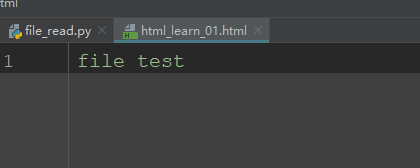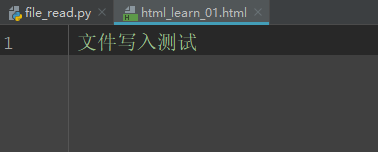python之实现文件的读写
很早之前做自动化测试,并没有将测试数据与数据库关联,而是直接通过json、ymal、excel等文件管理的。那么怎么用python读写文件呢?
在操作文件前,都需要打开文件,打开文件用内置函数open()
open函数
用于打开文件,创建一个file对象,常用格式为:
open(file, mode, encoding)
file:文件路径(可接收相对路径或者绝对路径)
mode:文件的打开模式,可选项,当不填写时默认为r模式
encoding:可选,一般使用utf8
完整格式:
open(file, mode, buffering, encoding, errors,newline, closefd,opener)
buffering:设置缓冲,可选项
errors:报错级别,可选项
newline:区分换行符
closefd:
opener:
mode常用模式:
r: 只读模式,意味着只能读,不能其他操作(追加写入、清空等) w: 只写模式,文件存在并有内容,则将文件内容全部清空,从0字节开始写,若文件不存在,则先创建文件后,再从0字节开始写 a: 追加模式,将光标置于内容末尾,从末尾开始写入,若文件不存在,则先创建文件后,再从末尾追加写入
b: 读写二进制文件(默认是t,表示文本),需要与上面几种模式搭配使用
实践出真知,打开个文件试试
# 传入绝对路径 f = open(file="D:\demo\htmls\html_learn_01.html") print(f) # 传入一个相对路径 t = open("./htmls/html_learn_01.html") print(t)
"D:\Program Files\Python\Python37-32\python.exe" D:/demo/file_read.py <_io.TextIOWrapper name='D:\\demo\\htmls\\html_learn_01.html' mode='r' encoding='cp936'> <_io.TextIOWrapper name='./htmls/html_learn_01.html' mode='r' encoding='cp936'>
可以看到,open()返回了一个文件对象
文件打开了,就要对文件进行一系列操作,常用操作有:
read():读取文件内容,可以指定读取文件内容大小,也可以读取全部内容,当不传或者传入负数,则表示读取文件全部内容。
读取全部(一)
# 传入一个相对路径 t = open("./htmls/html_learn_01.html", encoding="utf-8") # 读取全部内容 content = t.read() print(content)
"D:\Program Files\Python\Python37-32\python.exe" D:/demo/file_read.py <!DOCTYPE html> <html lang="en"> <head> <meta charset="UTF-8"> <title>html lean</title> </head> <body> <h1>我是第一个标题</h1> <p>我的第一个段落</p> </body> </html> Process finished with exit code 0
读取全部(二)
# 传入一个相对路径 t = open("./htmls/html_learn_01.html", encoding="utf-8") # 读取全部内容 content = t.read(-1) print(content)
"D:\Program Files\Python\Python37-32\python.exe" D:/demo/file_read.py <!DOCTYPE html> <html lang="en"> <head> <meta charset="UTF-8"> <title>html lean</title> </head> <body> <h1>我是第一个标题</h1> <p>我的第一个段落</p> </body> </html> Process finished with exit code 0
读取部分内容
# 传入一个相对路径 t = open("./htmls/html_learn_01.html", encoding="utf-8") # 读取部分内容 content = t.read(20) print(content)
"D:\Program Files\Python\Python37-32\python.exe" D:/demo/file_read.py <!DOCTYPE html> <htm Process finished with exit code 0
readline():从文件中读取整行内容,若不传或者传入负数,则返回整行内容(包括换行符'\n'),否则返回指定字节大小内容,
读取整行内容(一)
# 传入一个相对路径 t = open("./htmls/html_learn_01.html", encoding="utf-8") # 读取整行内容 content = t.readline() print(content)
"D:\Program Files\Python\Python37-32\python.exe" D:/demo/file_read.py <!DOCTYPE html> Process finished with exit code 0
读取整行内容(二)
# 传入一个相对路径 t = open("./htmls/html_learn_01.html", encoding="utf-8") # 读取整行内容 content = t.readline(-9) print(content)
"D:\Program Files\Python\Python37-32\python.exe" D:/demo/file_read.py <!DOCTYPE html> Process finished with exit code 0
读取一行中部分内容
# 传入一个相对路径 t = open("./htmls/html_learn_01.html", encoding="utf-8") # 读取一行中部分内容 content = t.readline(5) print(content)
"D:\Program Files\Python\Python37-32\python.exe" D:/demo/file_read.py <!DOC Process finished with exit code 0
readlines():从文件中读取文件内容,不传或者传入负数时返回所有行所组成的列表,传入时返回指定字节所在行内所组成的列表
读取全部内容(一)
# 传入一个相对路径 t = open("./htmls/html_learn_01.html", encoding="utf-8") # 读取整个文件内容 content = t.readlines() print(content)
"D:\Program Files\Python\Python37-32\python.exe" D:/demo/file_read.py ['<!DOCTYPE html>\n', '<html lang="en">\n', '<head>\n', ' <meta charset="UTF-8">\n', ' <title>html lean</title>\n', '</head>\n', '<body>\n', '<h1>我是第一个标题</h1>\n', '<p>我的第一个段落</p>\n', '</body>\n', '</html>'] Process finished with exit code 0
读取全部内容(二)
# 传入一个相对路径 t = open("./htmls/html_learn_01.html", encoding="utf-8") # 读取整个文件内容 content = t.readlines(-3) print(content)
"D:\Program Files\Python\Python37-32\python.exe" D:/demo/file_read.py ['<!DOCTYPE html>\n', '<html lang="en">\n', '<head>\n', ' <meta charset="UTF-8">\n', ' <title>html lean</title>\n', '</head>\n', '<body>\n', '<h1>我是第一个标题</h1>\n', '<p>我的第一个段落</p>\n', '</body>\n', '</html>'] Process finished with exit code 0
读取部分内容
# 传入一个相对路径 t = open("./htmls/html_learn_01.html", encoding="utf-8") # 读取整个文件内容 content = t.readlines(19) print(content)
"D:\Program Files\Python\Python37-32\python.exe" D:/demo/file_read.py ['<!DOCTYPE html>\n', '<html lang="en">\n'] Process finished with exit code 0
for line in file: 在读取文件时还可用迭代器获取文件内容
# 传入一个相对路径 t = open("./htmls/html_learn_01.html", encoding="utf-8") # 逐行打印文件内容 for line in t: print(line)
"D:\Program Files\Python\Python37-32\python.exe" D:/demo/file_read.py <!DOCTYPE html> <html lang="en"> <head> <meta charset="UTF-8"> <title>html lean</title> </head> <body> <h1>我是第一个标题</h1> <p>我的第一个段落</p> </body> </html> Process finished with exit code 0
write():将内容写入文件并返回所写内容长度,如果要写入字符串以外的类型数据,需要进行类型转换,否则抛出TypeError: write() argument must be str, not int错误
以只写模式(w)写入已存在的文件中
# 传入一个相对路径 t = open("./htmls/html_learn_01.html", mode="w", encoding="utf-8") tt = t.write("file test") print(tt)
"D:\Program Files\Python\Python37-32\python.exe" D:/demo/file_read.py 9 Process finished with exit code 0
写入后文件内容:

以只写模式(w)写入不存在的文件中
# 传入一个相对路径 t = open("./htmls/create.html", mode="w", encoding="utf-8") tt = t.write("file test") print(tt)
"D:\Program Files\Python\Python37-32\python.exe" D:/demo/file_read.py 9 Process finished with exit code 0
创建了一个文件并写入内容

以追加写入模式(a)写入已存在的文件中
# 传入一个相对路径 t = open("./htmls/html_learn_01.html", mode="a", encoding="utf-8") tt = t.write("mode a") print(tt)
"D:\Program Files\Python\Python37-32\python.exe" D:/demo/file_read.py 6 Process finished with exit code 0
将内容追加写入到文件末尾

以追加写入模式(a)写入不存在的文件中的情况与w模式一样,此处不再举例
writelines():将内容写入文件,接收单个字符串、字符串组成的序列
写入单个字符串
# 传入一个相对路径 t = open("./htmls/html_learn_01.html", mode="w+", encoding="utf-8") t.writelines("文件写入测试")

写入一个字符串序列
# 传入一个相对路径 t = open("./htmls/html_learn_01.html", mode="w+", encoding="utf-8") t.writelines(["第一行\n", "第二行\n", "第三行\n"])

写入一个由迭代对象产生的字符串序列
# 传入一个相对路径 t = open("./htmls/html_learn_01.html", mode="w+", encoding="utf-8") t.writelines([(lambda x: str(x))(x) for x in range(5)])

writable():判断文件是否可写,如果可写返回True,否则返回False
# 文件不可写时返回False t = open("./htmls/html_learn_01.html", mode="r", encoding="utf-8") result = t.writable() print(result)
"D:\Program Files\Python\Python37-32\python.exe" D:/demo/file_read.py False
# 文件可写时返回True t = open("./htmls/html_learn_01.html", mode="w", encoding="utf-8") result = t.writable() print(result)
"D:\Program Files\Python\Python37-32\python.exe" D:/demo/file_read.py True
close():关闭已打开的文件(使用open打开文件并操作完后不会自动关闭文件,如果不关闭文件时,进行其他类操作就会报错)
import os # 不关闭文件时移除文件 t = open("./htmls/html_learn_01.html", mode="w", encoding="utf-8") t.writelines(["wo\n", "wo\n"]) os.remove("./htmls/html_learn_01.html")
"D:\Program Files\Python\Python37-32\python.exe" D:/demo/file_read.py Traceback (most recent call last): File "D:/demo/file_read.py", line 8, in <module> os.remove("./htmls/html_learn_01.html") PermissionError: [WinError 32] 另一个程序正在使用此文件,进程无法访问。: './htmls/html_learn_01.html'
import os # 关闭文件后移除文件 t = open("./htmls/html_learn_01.html", mode="w", encoding="utf-8") t.writelines(["wo\n", "wo\n"]) t.close() os.remove("./htmls/html_learn_01.html")
"D:\Program Files\Python\Python37-32\python.exe" D:/demo/file_read.py Process finished with exit code 0
每次打开文件后需要调用close()关闭文件也是挺麻烦的,而且若忘记关闭文件了,会造成意想不到的错误,若想避免,则可引入with
with open() as 文件打开操作完后会自动关闭文件
import os # 使用with open() as 操作完文件后会自动关闭文件,此时调用os.remove()删除不会报异常 with open("./htmls/html_learn_011.html", mode="w", encoding="utf-8") as f: f.writelines(["wo\n", "wo\n"]) os.remove("./htmls/html_learn_011.html")
"D:\Program Files\Python\Python37-32\python.exe" D:/demo/file_read.py Process finished with exit code 0
遍历文件后移除文件
import os # 遍历文件内容,删除文件 with open("./htmls/html_learn_011.html", mode="r", encoding="utf-8") as f: datas = f.readlines() for data in datas: print(data.strip()) os.remove("./htmls/html_learn_011.html")
"D:\Program Files\Python\Python37-32\python.exe" D:/demo/file_read.py 读 写 背 Process finished with exit code 0
文件的基础操作就这样啦,后续会继续补充,下一篇实现文件读取封装





【推荐】国内首个AI IDE,深度理解中文开发场景,立即下载体验Trae
【推荐】编程新体验,更懂你的AI,立即体验豆包MarsCode编程助手
【推荐】抖音旗下AI助手豆包,你的智能百科全书,全免费不限次数
【推荐】轻量又高性能的 SSH 工具 IShell:AI 加持,快人一步
· 从 HTTP 原因短语缺失研究 HTTP/2 和 HTTP/3 的设计差异
· AI与.NET技术实操系列:向量存储与相似性搜索在 .NET 中的实现
· 基于Microsoft.Extensions.AI核心库实现RAG应用
· Linux系列:如何用heaptrack跟踪.NET程序的非托管内存泄露
· 开发者必知的日志记录最佳实践
· TypeScript + Deepseek 打造卜卦网站:技术与玄学的结合
· Manus的开源复刻OpenManus初探
· AI 智能体引爆开源社区「GitHub 热点速览」
· 从HTTP原因短语缺失研究HTTP/2和HTTP/3的设计差异
· 三行代码完成国际化适配,妙~啊~